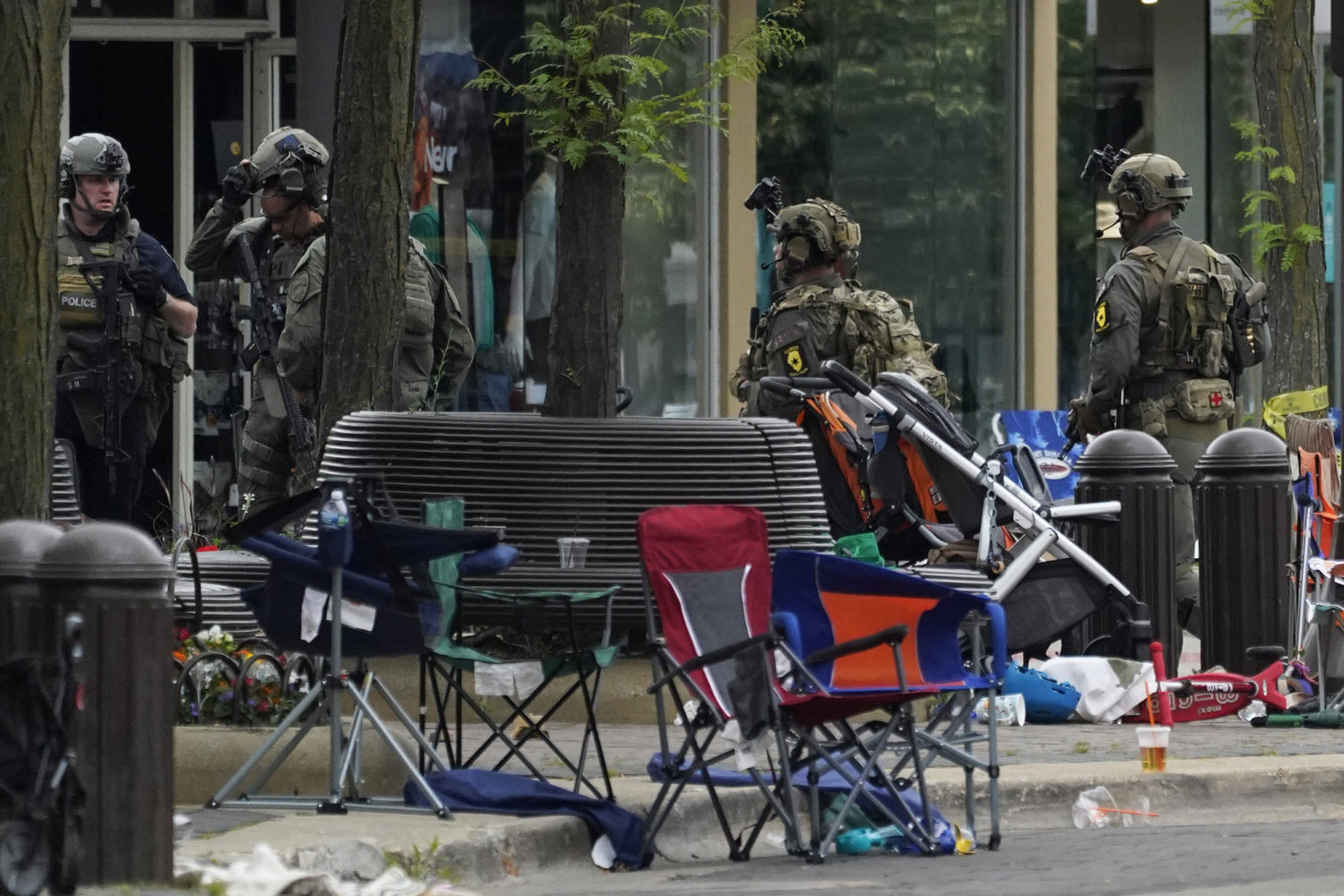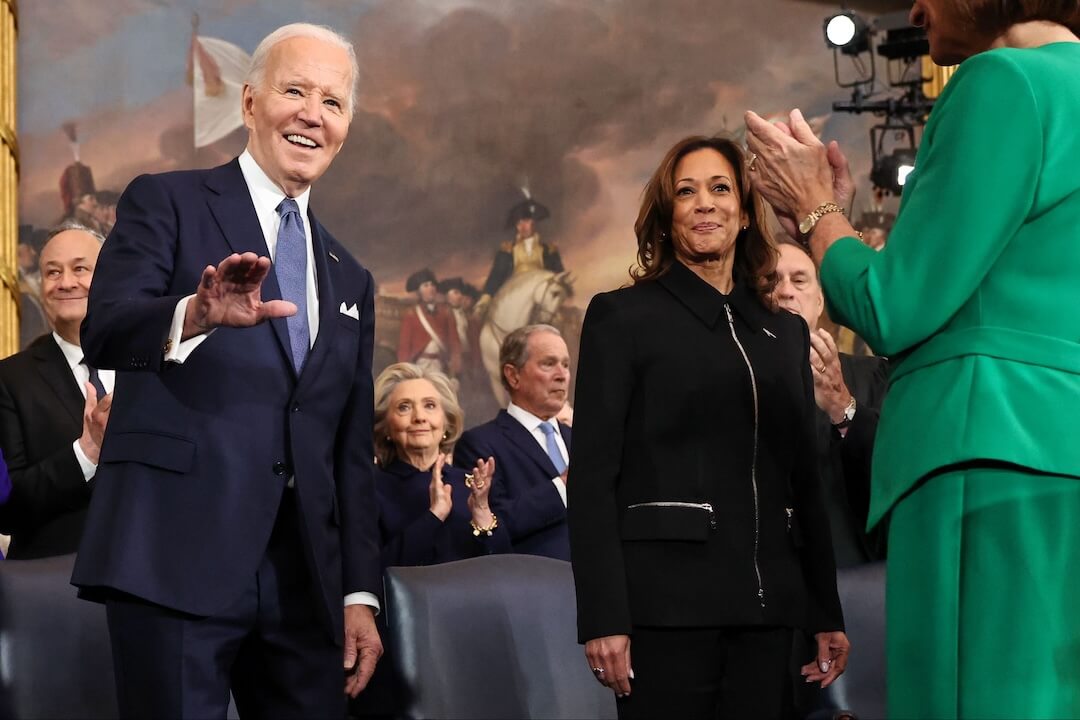When a mass shooter opened fire on a Fourth of July parade in a Chicago suburb, the Chicago Sun-Times’ Washington bureau chief, Lynn Sweet, happened to be at the parade.
Jennifer Kho, the paper’s new executive editor, had been on the job for three weeks. Kho read me Sweet’s first post on the city desk Slack channel. “Heads up. So, I’m at that Highland Park parade, possible shooting incident, panic hitting parade, call me.”
That channel became the primary place for coordinating the breaking news coverage. An audience editor embedded the first social posts. Other staff members reported for work. And Sweet contributed descriptions and quotes from witnesses.
Reading through that Slack history, Kho recreates the day. The first stories went live. The Sun-Times website partially crashed. The coverage evolved.
In those early minutes, Sweet posted three photos to Slack of what she saw, taken on her phone.
When Kho accepted the offer to run the Sun-Times, she envisioned a Sept. 1 start date, giving her a chance to relocate from Los Angeles and wind down several consulting jobs.
When the Sun-Times’ interim editor resigned, Kho gamely agreed to step in immediately in early June. She flew to Chicago, caught COVID-19 and spent most of the time in a hotel room, running the Supreme Court abortion decision coverage and meeting people by Zoom. She was back in Los Angeles, sleeping, on July 4 when she awoke to a flurry of calls breaking through her do-not-disturb settings.
After the first stories went online, Dave Newbart, the interim managing editor, asked Kho what she wanted to do with Sweet’s photos. Sweet describes her experience in a first-person column that was published that day.
In one photo, a man in shorts lies dead on the sidewalk on his back, his legs and shoes soaked in bright-red blood, which was still flowing from his body. In another photo, at the base of a bench, thick, dark blood coagulates. In the third photo, two women are dead, sprawled on concrete steps, their faces and shoulders covered, blood spilling down the steps. In the background are abandoned bikes and strollers. Someone is bending over another person on the ground.
“At first, I was like, ‘Oh my God this is gruesome,’ and, you know, we can’t run them,” Kho told me five days later. “But one of them in particular I just kept thinking about it. Like in a journalistic way I kept thinking about it. Like, ‘Oh my gosh this really tells the story.’ There’s so much chaos involved, that’s evident in the photo. People are covering up the dead and trying to help the wounded and people are still running and trying to get out. And I just kept thinking about it.”
I’ve had several conversations with Kho by text and phone since that day. As an executive, she’s pensive and inviting. She keeps her inclinations to herself as she seeks input. Although she was leaning toward running the photo, she asked her managing editor what he thought. He saw the value in running the photo of the women on the steps. They both wanted to talk to more people.
She reached out to the newsroom’s photo editor and a crime specialist. And she also reached out to Tracy Brown, chief content officer at WBEZ, Chicago’s public radio station and since Jan. 31 of this year, the owner of the Sun-Times.
WBEZ was mostly running the Sun-Times’ stories on their website. “When Jenn called me, I knew that what we had was pretty powerful,” Brown said. “It did give us a picture of mass shootings that we don’t usually get. So many of them happen indoors, in movie theaters or classrooms or places where we just don’t see the carnage in the way that we were able to see, mainly because Lynn Sweet happened to be there.”
Brown encouraged Kho to slow the decision down and to call me. I often guide journalists through difficult ethical decisions. When I talked to Kho via Zoom that day, I was struck by her patience and willingness to let the question of whether to publish go unanswered for a while. She wasn’t in a hurry to make a call.
“It’s not something you can take back,” Brown said. “I wanted to be mindful and careful. It’s a small town, there will be hundreds if not thousands of people who recognize those people, even though their faces are covered.”
As Kho shared the photos with me, I asked her about the journalistic purpose, and we discussed how the images documented the carnage of the AR-15-style weapon that was used. We also talked about the invasion of privacy, the graphic nature of the blood, whether the photos could or should be shared on social media, whether that could be prevented, how they should be displayed.
I didn’t tell her what to do. I walked her through an ethical process for each picture, articulating the value in publishing it, the harm it would cause and how she could minimize that harm.
Kho hung up and started drafting an editor’s note. She still wasn’t certain the Sun-Times would publish any of the pictures. But she was leaning toward publishing the one photo of the victims on the steps, cropped to shield one woman’s bare torso, on the website only, behind an interstitial panel that would require readers to click through to see. And she wanted to test her instincts by writing the note.
Her web folks told her they would have to build the click-to-see feature. Brown and I offered comments on her editor’s note.
Finally, the next day, after the technology was ready, after the editor’s note was revised, after Kho convened a news meeting to explain her reasoning and invite more feedback, the photo was published.
“After thinking about all these things and all the different ways that harm could be minimized, I felt pretty confident about the decision,” Kho said.
The response was silence at first. Because the photo was added to Sweet’s column after the traffic bump, for the most part the audience didn’t see it. Later, when the editor’s note was posted on social media, the audience began to react, mostly positively. But not all of it.
Here’s a representative sample of comments from Facebook
“Yay!!! Finally a media outlet with courage.”
“People need to see what these guns do to people.”
“Wow, that’s a long-winded way to say, ‘if it bleeds, it leads.’”
“You ran it to sell papers.”
Kho followed the comments closely and engaged. “I got in there and responded with people who had thoughtful comments either way, or who had misunderstood the facts.”
Here’s one exchange that happened in the comments on Facebook:
Facebook user Bobby Que wrote, “Why haven’t you shown anything concerning the Gary Indiana mass shooting also.” Kho wrote back, “We are a local Chicago paper and we didn’t have anyone in Indiana. But I have been following that coverage with sadness as well from the AP and the local news channels.”
Kho is leaning into the harder questions about how the Sun-Times and by extension, WBEZ, cover all violence. More people (10) died by gun violence in Chicago on the Fourth of July weekend than died in the mass shooting at the parade.
Brown and Kho both told me that WBEZ’s acquisition of the Sun-Times is designed to do more than harness the power of two very different newsrooms — a quintessential public radio station that is home to This American Life and the oldest continuously published daily newspaper in Chicago.
“It’s not just about the journalism,” Brown said. “It’s about how we can strengthen the community.”
WBEZ reaches roughly 500,000 to 600,000 radio listeners cumulatively over a week, Brown said. And WBEZ’s website sees roughly 200,000 weekly pageviews. The Chicago Sun-Times gets roughly 250,000 daily pageviews on average (although they got 4 million on July 4 and more than 7 million on July 5). They deliver about 87,000 printed papers a day. Together, Brown said the two newsrooms reach 2 million people a day in the Chicago area.
Kho was previously manager of HuffPost and the Guardian U.S. The Sun-Times is her first leadership role in a local newsroom. Her vision for the newsroom involves collaborating with communities throughout the region to “Democratize news and become a sustainable model for fixing much of what’s broken about journalism today,” she wrote. “I think community journalism should be innovative, deeply engaged in its community and making valuable contributions to its audiences’ lives every day, and I want the Sun-Times to be one of the most impactful, respected and beloved local news organizations in the country.”
How is she going to get there? While she’s got ambitious plans to listen, to invite communities into the coverage, she admits transforming crime coverage into more useful public safety journalism is a daunting problem.
“It’s a conversation the newsroom is eager to have and I would really like to have with the community. We’re going to need a lot of help with it,” she said. “I’ve never been in charge of a newsroom where crime was such a large part of the coverage.”
Just like publishing the photo, Kho tells me it will likely take a long time.
Correction: WBEZ reaches 500,000 to 600,000 people cumulatively each week. An earlier version reported a higher number.







